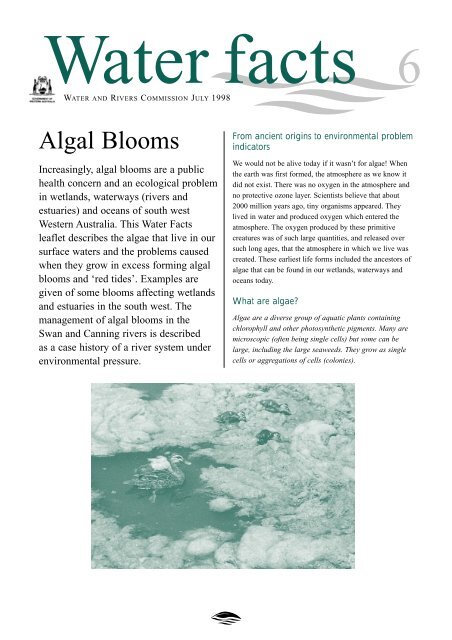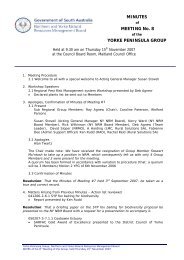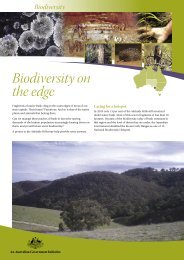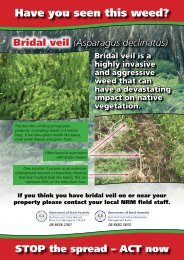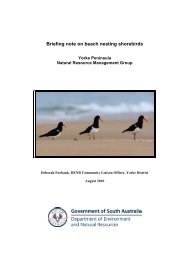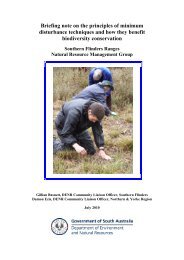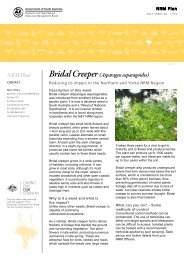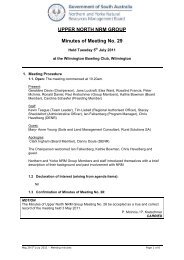Algal Bloom Fact sheet - Department of Water - The Western ...
Algal Bloom Fact sheet - Department of Water - The Western ...
Algal Bloom Fact sheet - Department of Water - The Western ...
You also want an ePaper? Increase the reach of your titles
YUMPU automatically turns print PDFs into web optimized ePapers that Google loves.
<strong>Water</strong> facts 6<br />
WATER AND RIVERS COMMISSION JULY 1998<br />
<strong>Algal</strong> <strong>Bloom</strong>s<br />
Increasingly, algal blooms are a public<br />
health concern and an ecological problem<br />
in wetlands, waterways (rivers and<br />
estuaries) and oceans <strong>of</strong> south west<br />
<strong>Western</strong> Australia. This <strong>Water</strong> <strong>Fact</strong>s<br />
leaflet describes the algae that live in our<br />
surface waters and the problems caused<br />
when they grow in excess forming algal<br />
blooms and ‘red tides’. Examples are<br />
given <strong>of</strong> some blooms affecting wetlands<br />
and estuaries in the south west. <strong>The</strong><br />
management <strong>of</strong> algal blooms in the<br />
Swan and Canning rivers is described<br />
as a case history <strong>of</strong> a river system under<br />
environmental pressure.<br />
From ancient origins to environmental problem<br />
indicators<br />
We would not be alive today if it wasn’t for algae! When<br />
the earth was first formed, the atmosphere as we know it<br />
did not exist. <strong>The</strong>re was no oxygen in the atmosphere and<br />
no protective ozone layer. Scientists believe that about<br />
2000 million years ago, tiny organisms appeared. <strong>The</strong>y<br />
lived in water and produced oxygen which entered the<br />
atmosphere. <strong>The</strong> oxygen produced by these primitive<br />
creatures was <strong>of</strong> such large quantities, and released over<br />
such long ages, that the atmosphere in which we live was<br />
created. <strong>The</strong>se earliest life forms included the ancestors <strong>of</strong><br />
algae that can be found in our wetlands, waterways and<br />
oceans today.<br />
What are algae?<br />
Algae are a diverse group <strong>of</strong> aquatic plants containing<br />
chlorophyll and other photosynthetic pigments. Many are<br />
microscopic (<strong>of</strong>ten being single cells) but some can be<br />
large, including the large seaweeds. <strong>The</strong>y grow as single<br />
cells or aggregations <strong>of</strong> cells (colonies).
Thrombolites and stromatolites<br />
Microbialites are rock-like structures built by<br />
microorganisms, principally blue greens (cyanobacteria).<br />
Stromatolites are one form <strong>of</strong> microbialite, and those at<br />
Hamelin Pool, Shark Bay are probably the best known.<br />
Fossil stromatolites represent the earliest record <strong>of</strong> life<br />
on earth. Thrombolites are a particular type <strong>of</strong><br />
microbialite that have a clotted internal structure, unlike<br />
stromatolites which are layered in cross section. Lake<br />
Clifton, a lake 100 kilometres from Perth, supports a<br />
thrombolite reef over 6km long and up to 120m wide<br />
and has structures up to 1.3m high, possibly the largest<br />
living thrombolite reef in the southern hemisphere.<br />
<strong>The</strong> Lake Clifton thrombolites represent modern-day<br />
examples <strong>of</strong> thrombolites that were common some 600<br />
million years ago, whose fossil counterparts are found<br />
today in the Amadeus Basin, Northern Territory where<br />
ancient shorelines once existed.<br />
Stromatolite means layered rock.<br />
Thrombolite is derived from the same root as thrombosis,<br />
which means clot.<br />
Algae are very diverse<br />
Algae are amazingly diverse in size, shape and colour.<br />
<strong>The</strong>y include a variety <strong>of</strong> aquatic plants ranging from<br />
single-celled plants that are invisible to the naked eye to<br />
giant kelps that can grow up to 45 metres and weigh as<br />
much as a small tree. Algae can be found on soil, beneath<br />
polar ice and in snow, but greatest numbers are found in<br />
the waters that cover 70 per cent <strong>of</strong> the earth’s surface.<br />
It is the chlorophyll and other photosynthetic pigments<br />
that give algae their characteristic colours. Most people<br />
have seen piles <strong>of</strong> green or brownish weed stranded along<br />
an estuary or ocean shoreline, or noticed lake waters turn a<br />
murky ‘pea soup’ green colour.<br />
Photosynthesis is the conversion <strong>of</strong> carbon dioxide and<br />
water to carbohydrates using light energy. Oxygen is<br />
produced in the process.<br />
<strong>The</strong> most familiar algae to many people are the large<br />
green, brown or red seaweeds, but there are several<br />
thousand species <strong>of</strong> algae and most <strong>of</strong> them are<br />
microscopically small.<br />
Phytoplankton<br />
Phytoplankton are the plant component <strong>of</strong> plankton.<br />
Phytoplankton are microscopic (up to 1-2mm in diameter)<br />
free-floating or weakly mobile aquatic plants e.g. diatoms,<br />
din<strong>of</strong>lagellates, chlorophytes, cyanobacteria.<br />
Microscopic algae, including diatoms and chlorophytes<br />
(microscopic green algae), are a major component <strong>of</strong><br />
phytoplankton. However not all organisms in the<br />
phytoplankton are algae. Other organisms include<br />
din<strong>of</strong>lagellates (Dinophyta), which cause ‘red tides’, and<br />
cyanobacteria (Cyanophyta or Myxophyceae), which<br />
cause blue-green blooms.<br />
Linda Moore, <strong>Water</strong> and Rivers Commission Principal Research<br />
Officer, at the Lake Clifton thrombolites.<br />
<strong>The</strong> Canning River is among the waterways that have<br />
suffered from blooms that turn the water a bright bluegreen<br />
colour. In still conditions the scum on the surface<br />
can look like a vast spill <strong>of</strong> green paint!<br />
Cyanobacteria are an ancient group <strong>of</strong> photosynthetic<br />
bacteria. Like true algae, they get their own energy<br />
requirements for growth from sunlight. Cyanobacterial<br />
blooms and red tides are not strictly speaking algal blooms<br />
(although they are commonly referred to as such). <strong>The</strong>y<br />
are included in this <strong>Fact</strong> <strong>sheet</strong> because they are <strong>of</strong><br />
significant concern in <strong>Western</strong> Australia.<br />
Blue-green bloom in the Canning River
Common types <strong>of</strong> phytoplankton in south-west<br />
<strong>Western</strong> Australia<br />
<strong>The</strong> major types <strong>of</strong> phytoplankton found in the waterways<br />
and wetlands <strong>of</strong> south-west <strong>Western</strong> Australia include:<br />
Din<strong>of</strong>lagellates - red tides<br />
Din<strong>of</strong>lagellates are organisms in which the body form is a<br />
single cell or colony <strong>of</strong> cells with threadlike extensions <strong>of</strong><br />
the cell called flagella which are used for locomotion.<br />
Red tides are commonly caused by din<strong>of</strong>lagellates which<br />
colour the water red/brown. Din<strong>of</strong>lagellates form an<br />
important part <strong>of</strong> the diet <strong>of</strong> many shellfish, and are a key<br />
component <strong>of</strong> the phytoplankton. <strong>The</strong>y occur naturally in<br />
many water bodies and in small numbers are harmless, but<br />
under certain conditions they can multiply rapidly and<br />
become so dense that they discolour the water.<br />
Din<strong>of</strong>lagellate red tides in the upper reaches <strong>of</strong> the Swan<br />
River have caused problems for swimmers because they<br />
cling to hair, skin and bathers.<br />
<strong>Bloom</strong> in the Murray River<br />
Red tides are regularly observed in the Swan-Canning<br />
estuary, Serpentine and Murray River estuaries and the<br />
Collie River. In late summer, blooms <strong>of</strong> the non-toxic<br />
Gymnodinium simplex in the upper Swan River at<br />
Bassendean have led to warnings being issued to advise<br />
people to avoid the bloom, which is more <strong>of</strong> a nuisance<br />
than a health hazard. <strong>Bloom</strong>s containing Alexandrium<br />
pseudogonyaulax, along with other species, in the<br />
Murray River and Yunderup Canals have been<br />
associated with production <strong>of</strong> a mucus that traps other<br />
phytoplankton and supports bacteria. Scumming on the<br />
surface during hot weather, and the associated high<br />
levels <strong>of</strong> bacteria, have necessitated warnings to the<br />
public to avoid affected areas.<br />
Din<strong>of</strong>lagellate bloom scum adhering to swimmers in the Swan<br />
River estuary. (Photograph reproduced with permission <strong>of</strong><br />
Mr R. Irving, Community Newspapers).<br />
About 30 species produce powerful neurotoxins (nerve<br />
poisons) that can affect humans. People who eat seafood<br />
contaminated by din<strong>of</strong>lagellate toxins can suffer from<br />
severe gastrointestinal and neurological illnesses such as<br />
Paralytic Shellfish Poisoning (PSP). In extreme cases PSP<br />
can be fatal. <strong>The</strong> toxic marine/estuarine din<strong>of</strong>lagellate<br />
Alexandrium minutum has been recorded in very low<br />
numbers in <strong>Western</strong> Australia. Other potentially harmful<br />
species Gymnodinium breve-like, Gambierdiscus and<br />
Dinophysis acuminata have also been recorded.<br />
Alexandrium (magnified)
Diatoms<br />
If you have a swimming pool filter or kitty litter, you may<br />
have been using diatom skeletons! Microscopic diatoms<br />
were among the first living organisms. Diatoms are found<br />
all around the world and are the dominant form <strong>of</strong> life in<br />
many aquatic environments. <strong>The</strong>y are very diverse and<br />
more than 400 species have been recorded in the Swan<br />
River system. <strong>The</strong>se tiny yellow or brown plants live<br />
within glass-like cell walls made from silica. <strong>The</strong>y have<br />
amazing shapes - some look like jewels, others like<br />
spaceships. When the diatoms die, they sink to the bottom<br />
<strong>of</strong> the lake, river or ocean floor. Here, their empty cell<br />
walls accumulate and form deposits called diatomaceous<br />
earth. This can be mined as diatomite for use in a variety<br />
<strong>of</strong> ways including as a cutting agent in car polish, in pool<br />
filters and water treatment systems, and as a thickener in<br />
paint. Fossil diatom cell walls also hold clues to how the<br />
environment has changed in the past. Studies <strong>of</strong> Lake<br />
Monger in Perth have shown that it has marine diatom<br />
cells deep in the sediments - a reminder <strong>of</strong> the time when<br />
this land was under the ocean.<br />
Diatom cell walls (highly magnified)<br />
Many species <strong>of</strong> benthic (bottom-dwelling), epiphytic<br />
(living on the surface <strong>of</strong> other plants) and planktonic<br />
diatoms are found in <strong>Western</strong> Australia. Diatoms<br />
commonly bloom in south-west waterways, turning the<br />
water a murky yellow-brown colour. Harmless dense<br />
blooms have occurred in the Peel-Harvey estuary and<br />
lower Swan River estuary. In recent years several toxic<br />
diatoms (Pseudonitzschia) have been found in other parts<br />
<strong>of</strong> the world and have resulted in shellfish toxicity and the<br />
deaths <strong>of</strong> humans and brown pelicans. Some species <strong>of</strong><br />
marine diatoms have barbs which can damage fish gills.<br />
A common diatom that appears every year in the Swan<br />
River estuary is Skeletonema costatum. It usually<br />
appears in spring in Melville <strong>Water</strong> when the estuary<br />
becomes more saline after winter run <strong>of</strong>f. Skeletonema<br />
can be found upstream past Maylands as the saline<br />
water moves upstream in summer. This harmless chainforming<br />
diatom is<br />
an excellent food<br />
source for<br />
invertebrates<br />
such as copepods<br />
and mussels.<br />
Skeletonema (magnified)<br />
Microscopic green algae<br />
Green microalgae (Chlorophyta) are <strong>of</strong>ten found in fresh<br />
water and frequently have flagella (tails) to help them<br />
swim. <strong>The</strong>y are non-toxic but when blooms die and<br />
decompose rapidly they can use up all the oxygen in the<br />
water.<br />
<strong>The</strong> microscopic green alga Chlamydomonas <strong>of</strong>ten<br />
colours the upper reaches <strong>of</strong> the Swan River a bright<br />
green in spring (October-November). It is a harmless<br />
freshwater species, and can occur as far downstream as<br />
Perth <strong>Water</strong> after very wet winters. Filamentous<br />
Rhizoclonium blooms annually in the Canning River<br />
estuary near Shelley Bridge.<br />
Epiphytic diatom (Synedra).<br />
Chaetoceros barbs<br />
Chlamydomonas cells under<br />
the microscope<br />
Inset: Magnified cell<br />
Epiphytic diatom Licmophora
Diatom Asterionellopsis<br />
Diatom Chaetoceros<br />
Striatella<br />
Diatoms<br />
Gramatophora<br />
Licmophora<br />
Din<strong>of</strong>lagellate Ceratium<br />
Diatom Nitzschia<br />
Diatom Pleurosigma<br />
Diatom Skeletonema<br />
Examples <strong>of</strong> phytoplankton found in south-west estuaries.
Cyanobacteria: blue greens<br />
Cyanobacteria, or blue greens, are primitive single-celled<br />
organisms that have no cell nucleus and are related to<br />
bacteria. <strong>The</strong> microscopic cells form colonies or<br />
threadlike chains (filaments). Like plants, they use light<br />
energy for photosynthesis.<br />
Blue greens were among the first forms <strong>of</strong> life on earth.<br />
<strong>The</strong>y dominated the earth for millions <strong>of</strong> years, producing<br />
carbohydrates from solar energy and releasing oxygen<br />
which made the evolution <strong>of</strong> higher life forms possible.<br />
Cyanobacteria were responsible for the blooms that have<br />
caused costly environmental problems in the eastern states<br />
in the Murray-Darling river system. Many <strong>of</strong> our local<br />
wetlands, rivers and estuaries have experienced<br />
cyanobacterial blooms.<br />
Blue greens are widely distributed wherever there is water.<br />
<strong>The</strong>y grow naturally in Australia in fresh and saline<br />
waters. Still and confined waters, with warm surface<br />
water, tend to promote conditions where blooms <strong>of</strong><br />
cyanobacteria develop, particularly if the water has plenty<br />
<strong>of</strong> nutrients in it. When they bloom they discolour the<br />
water blue-green, khaki, or green. During calm weather, a<br />
scum may form on the surface that looks like green or<br />
bright blue paint and sometimes like jelly. Affected<br />
waterbodies include urban wetlands, poorly flushed<br />
nutrient-enriched south-west estuaries, river pools, farm<br />
dams, coastal marine areas, and even hot springs.<br />
Several species produce potent toxins. <strong>The</strong>se toxins are<br />
only dangerous to humans under certain conditions, and<br />
this is not fully understood. Potentially toxic blue-green<br />
blooms <strong>of</strong> Anabaena, Microcystis and Nodularia have<br />
been a regular occurrence in some <strong>Western</strong> Australian<br />
wetlands for many years. Long chains <strong>of</strong> Anabaena are<br />
usually found in rivers and lakes; the spherical colonies <strong>of</strong><br />
Microcystis are most common in lakes and reservoirs; the<br />
filaments <strong>of</strong> Nodularia are found in fresh and brackish<br />
lakes, rivers and estuaries, but rarely in saline waters.<br />
Some blue greens have the potential to cause asthma-like<br />
symptoms in people if inhaled as a fine mist, for example<br />
when contaminated waterbodies are used as a source for<br />
sprinkler irrigation. Children swimming in such waters<br />
may also be at risk, and there are maximum permissable<br />
guidelines for recreational contact with blooms and scums.<br />
Toxic species are also a risk to livestock and domestic<br />
animals that may drink or swim in contaminated waters.<br />
Blue-green blooms can kill native birds and upset the<br />
ecological balance <strong>of</strong> a wetland. <strong>The</strong>y can pose a threat to<br />
human health by direct skin contact and through<br />
consumption <strong>of</strong> filter-feeding shellfish such as mussels.<br />
In recent years, dense cyanobacterial blooms have affected<br />
many south-west waterways and contaminated areas have<br />
been closed to recreational use, domestic use and stock<br />
watering after dogs were reported to have become ill after<br />
drinking from the Blackwood River.<br />
<strong>The</strong> potentially toxic blue green Nodularia has been<br />
found in the Peel-Harvey estuary, Serpentine, Vasse-<br />
Wonnerup, Swan-Avon and Blackwood rivers. It can<br />
cause skin irritation. It was a serious problem in the<br />
Harvey Estuary until construction <strong>of</strong> the Dawesville<br />
Channel made conditions in the estuary more marine<br />
and less favourable for Nodularia.<br />
Nodularia (magnification <strong>of</strong> chain <strong>of</strong> cells)`<br />
Anabaena (magnified)<br />
Microcystis (magnified)
Macroalgae in south-west <strong>Western</strong> Australia<br />
Macroalgae are algae that can be seen by the unaided<br />
human eye, in contrast to microscopic algae which must<br />
be studied under the microscope.<br />
Macro means large. <strong>The</strong> piles <strong>of</strong> weed <strong>of</strong>ten washed up<br />
onto river beaches and foreshores are macroalgae, and<br />
sometimes also include seagrass. Macroalgae can be a few<br />
centimetres to many metres long, and are <strong>of</strong>ten referred to<br />
as seaweed or weed.<br />
<strong>The</strong>y can be free-floating or fixed to a substrate (solid<br />
surface) such as rocks, shells, other algae or jetty pylons.<br />
<strong>The</strong>y may be green, brown or red, and grow in a variety <strong>of</strong><br />
forms including large leafy types like sea lettuce,<br />
filaments, clumps and balls. Some grow in different ways<br />
in different environments. For example Cladophora<br />
appeared in the Peel-Harvey estuary as small dark green<br />
cottonwool-like balls forming a carpet on the bottom. In<br />
the Swan River estuary it appears in small clumps on jetty<br />
pylons and boat ramps.<br />
Excessive growth <strong>of</strong> green macroalgae created a costly<br />
problem in the Peel-Harvey estuary. Abundant weed<br />
growth in the 1960s was the first sign that the estuary<br />
environment was deteriorating. Rotting weed caused a<br />
terrible smell <strong>of</strong> hydrogen sulphide and smothered<br />
fringing vegetation. <strong>The</strong> Peel Inlet Management<br />
Authority has harvested the algae in shallow water to<br />
keep beaches clean for recreational use and lessen the<br />
impact on nearby residents. Weed harvesting and the<br />
Dawesville Channel, built to improve water quality in<br />
the estuary, cost more than sixty million dollars. <strong>The</strong><br />
Leschenault Estuary at Bunbury has about the same<br />
level <strong>of</strong> weed growth as the Peel Inlet, but it does not<br />
usually cause a problem because the weed rarely blows<br />
up onto beaches near residential areas.<br />
Common types <strong>of</strong> macroalgae in the waterways <strong>of</strong> the<br />
south west are Gracilaria, Ceramium, Polysiphonia (reds),<br />
Cladophora (goat weed), Chaetomorpha (ropeweed),<br />
Rhizoclonium, Enteromorpha, Ulva (sea lettuce),<br />
Caulerpa (greens), and Giffordia/Hinksia (browns).<br />
Harvester on Peel Inlet<br />
Gracilaria x 100<br />
Polysiphonia x 500<br />
Chaetomorpha x 100<br />
Cladophora x 115
Health Warning<br />
In waters that are used for recreation, even non-toxic<br />
cyanobacterial blooms can cause allergic skin reactions<br />
or contact dermatitis in sensitive people. Accidentally<br />
swallowing small volumes <strong>of</strong> water contaminated by<br />
toxic Cyanobacteria can cause headaches, stomach<br />
cramps, nausea and diarrhoea.<br />
Most cyanobacterial poisoning <strong>of</strong> animals involves<br />
hepatotoxins (liver poisons) and leads to death within a<br />
few hours to a few days. Some strains <strong>of</strong> toxic<br />
cyanobacteria produce neurotoxins (nerve poisons)<br />
which can cause death within minutes to a few hours.<br />
Some are suspected to promote tumours.<br />
Toxins are not removed by boiling or by using<br />
household disinfectant.<br />
Pay attention to any signs warning<br />
people <strong>of</strong> blooms<br />
If you see warning signs or evidence <strong>of</strong> contaminated<br />
water in dams, rivers or lakes:<br />
• Ensure your animals do not drink or go in the water.<br />
(If your dog does go in the water, hose it down<br />
before it licks its coat).<br />
• Provide alternative water supplies for farm animals.<br />
• Avoid contact (e.g. swimming, water-skiing).<br />
• Do not touch any scum around the bank.<br />
• Do not drink the water.<br />
• If contact does occur, rinse it <strong>of</strong>f.<br />
If symptoms develop, seek medical advice<br />
If you are concerned about the safety <strong>of</strong> private water<br />
supplies, contact the Health <strong>Department</strong> on<br />
(08) 9222 4222.<br />
If you withdraw water from lakes or rivers:<br />
• Inspect the intake pipe regularly for scum.<br />
• Have any suspicious scums or colourations tested and<br />
identified.<br />
• Avoid showering or bathing in contaminated water.<br />
TO REPORT ALGAL BLOOMS IN WETLANDS AND RIVERS, PHONE<br />
THE WATER AND RIVERS COMMISSION ON (08) 9278 0300.
Alien invaders<br />
While many species <strong>of</strong> algae are native to our local<br />
waterways, others have been introduced. Toxic microalgae<br />
have been spread worldwide in the ballast water <strong>of</strong> ships<br />
from contaminated ports. <strong>The</strong>se cargo ships take in<br />
seawater (<strong>of</strong>ten containing various plants and animals) in<br />
one port and dump the water and its exotic cargo<br />
thousands <strong>of</strong> kilometres away in another port. Pest<br />
creatures and plants such as toxic algae have established<br />
themselves in ports around the world. Often these<br />
introduced plants and animals find themselves in ideal<br />
conditions free from the competitors and predators that<br />
kept them in check in their natural environments.<br />
About 155 million tonnes <strong>of</strong> ballast water are discharged<br />
into Australian ports each year. Some potentially harmful<br />
microalgal species are found in <strong>Western</strong> Australia, but<br />
their history is not known. This can pose a serious threat<br />
because some introduced species can survive for many<br />
years in the sediments around ports. Large industries have<br />
been threatened by introduced algae in other parts <strong>of</strong><br />
Australia. For example the shellfish industry in Tasmania<br />
was damaged by blooms <strong>of</strong> the toxic chain-forming<br />
din<strong>of</strong>lagellate Gymnodinium catenatum.<br />
<strong>The</strong> role <strong>of</strong> algae in waterways<br />
Without algae our waterways would be deprived <strong>of</strong><br />
oxygen and food and would become underwater deserts<br />
supporting few life forms. Without phytoplankton, there<br />
would be no Australian fishing industry.<br />
Algae play an extremely important role in the ecology <strong>of</strong><br />
rivers and estuaries. Microscopic algae are a major<br />
component <strong>of</strong> plankton - the population <strong>of</strong> small<br />
organisms that float, swim weakly or drift in the water and<br />
form the basis <strong>of</strong> aquatic food chains. Microscopic algae,<br />
especially diatoms, can also be important components <strong>of</strong><br />
the flora attached to submerged surfaces such as sediments<br />
and other plants. Both microscopic algae and macroalgae<br />
are important oxygen producers and are the major primary<br />
producers <strong>of</strong> organic carbon compounds in the world’s<br />
water bodies. Microalgae provide the basic food source for<br />
many filter feeders including oysters and mussels, for<br />
zooplankton including crustaceans, and for grazers, which<br />
form the diet <strong>of</strong> many fish and birds.<br />
Macroalgae are also important in the ecology <strong>of</strong> estuaries<br />
because they provide habitat for small animals such as<br />
molluscs and shrimps and ‘nursery’ areas for juvenile fish,<br />
crabs and prawns. <strong>The</strong>y also shelter fish and crustaceans<br />
from predators such as larger fish or birds and can help to<br />
reduce erosion along the shoreline.<br />
Algae provide the basis for aquatic<br />
food chains and habitat for fish,<br />
crabs and prawns
<strong>Algal</strong> blooms<br />
<strong>Algal</strong> bloom: the rapid excessive growth <strong>of</strong> algae,<br />
generally caused by high nutrient levels and favourable<br />
conditions. <strong>Bloom</strong>s can result in deoxygenation <strong>of</strong> the<br />
water mass when large masses <strong>of</strong> algae die and<br />
decompose, leading to the death <strong>of</strong> aquatic plants and<br />
animals.<br />
<strong>Algal</strong> blooms are not a new phenomenon - Captain Cook<br />
recorded an algal bloom during his voyage in 1770!<br />
Algae are a natural component <strong>of</strong> aquatic environments,<br />
and even when they are abundant, it is not necessarily a<br />
problem. Often a proliferation <strong>of</strong> microscopic algae can<br />
have beneficial effects on fisheries and aquaculture<br />
industries such as oyster or mussel farms by increasing the<br />
amount <strong>of</strong> food available. Macroalgae provide sheltered<br />
habitat for juvenile fish. In fact, the local fishery<br />
production in the Peel-Harvey estuary almost doubled in<br />
the 1970s when weed (macroalgae) growth in the estuary<br />
was at its peak, without a similar increase in fishing effort.<br />
However, when algal blooms increase in intensity and<br />
frequency, the results can cause community concern,<br />
health problems, and in some cases can be catastrophic to<br />
the environment. <strong>The</strong> impacts are ecological, social and<br />
economic.<br />
<strong>Algal</strong> blooms upset the delicate natural balance <strong>of</strong> plant<br />
and animal ecosystems in a waterway or wetland. <strong>The</strong>y<br />
can degrade recreation, conservation and scenic values,<br />
and interfere with economic uses such as fisheries and<br />
tourism. Weed that washes ashore and forms rotting piles<br />
on beaches can cause <strong>of</strong>fensive smells and become a<br />
health problem for nearby residents as well as a nuisance<br />
to beach users and fishers. An over-abundance <strong>of</strong> algae<br />
can choke a body <strong>of</strong> water such as a river, clog irrigation<br />
pipes, and block out the light other plants, such as<br />
seagrasses, need to produce food. Excessive weed growth<br />
can eventually kill seagrass beds. When an algal bloom<br />
dies the process <strong>of</strong> decay can use up all the available<br />
oxygen in the water, effectively suffocating other aquatic<br />
life. This can kill fish, crabs and other animals, especially<br />
those that are attached or sedentary (do not move around).<br />
Some species <strong>of</strong> algae produce toxins.<br />
Princess Royal Harbour at Albany has lost most <strong>of</strong><br />
its valuable Posidonia seagrass beds because <strong>of</strong><br />
nutrient pollution. A survey in 1988-89 showed that<br />
up to 90 per cent <strong>of</strong> the seagrass meadows had been<br />
lost since the 1960s, when they were considered to<br />
be in pristine condition. Excessive growth <strong>of</strong> large<br />
algae (Cladophora) had smothered and shaded out<br />
the seagrass.<br />
Cladophora<br />
Fish kills can result when decaying algae use<br />
up all the oxygen in the water.<br />
Midges and algal blooms<br />
Local government authorities spend hundreds <strong>of</strong> thousands <strong>of</strong> dollars each year trying to control midge outbreaks<br />
around urban wetlands. <strong>The</strong>se insects are small flies that do not bite, but their densities cause severe nuisance to<br />
people living around wetlands. Midge larvae live at the bottom <strong>of</strong> lakes and are a natural and important component<br />
<strong>of</strong> wetland ecosystems. When a wetland become eutrophic and large algal blooms occur, the dead and dying algal<br />
material accumulates on the bottom <strong>of</strong> the lake. This provides a ready food resource for midge larvae and some<br />
populations multiply to very high densities. When these larvae mature, they emerge from the wetland as adult flies<br />
and swarm in their thousands around lights, causing a nuisance to nearby human populations.
When is a growth <strong>of</strong> algae a bloom?<br />
Microscopic algae<br />
<strong>Algal</strong> blooms can represent very large numbers <strong>of</strong> algal<br />
cells. Some algal blooms have been recorded in excess <strong>of</strong><br />
800,000 cells per millilitre (mL) <strong>of</strong> water. An excessive<br />
growth <strong>of</strong> microscopic algae is defined as a bloom when it<br />
reaches high densities <strong>of</strong> cells in an ‘integrated sample’ -<br />
a water sample obtained by combining samples (or a core<br />
<strong>of</strong> water) taken from a range <strong>of</strong> depths.<br />
Macroalgae<br />
When macroalgae grow in excess, the growth can be<br />
measured in tonnes. For example, in the 1980s when weed<br />
growth was at a peak in the Peel-Harvey estuary, the Peel<br />
Inlet Management Authority harvested up to 20,000 tonnes<br />
per year in an attempt to keep foreshore beaches clean.<br />
How many algal cells make a bloom?<br />
If moderate to large algal cells (greater than 15 to 20<br />
microns in diameter) exceed 15,000 cells per mL <strong>of</strong><br />
water, it is referred to as a bloom. Small microscopic<br />
cells (less than 1-5 microns) discolour the water at much<br />
higher densities, around 100,000 cells per mL, to be<br />
considered a bloom. <strong>The</strong> concentration <strong>of</strong> algal cells on<br />
the surface can vary during the day, and can be 20-50<br />
times the ‘integrated’ density in calm conditions.<br />
However, impacts can result from lower densities - a<br />
bloom <strong>of</strong> a toxic species in a shellfish harvesting area<br />
could pose a threat at densities as low as 5 cells per mL.<br />
Cyanobacteria<br />
Cyanobacterial densities in excess <strong>of</strong> 15,000 cells<br />
per mL make the water unsafe for people to drink, and<br />
even densities <strong>of</strong> 500 to 2,000 cells per mL require<br />
action by water managers.<br />
Eutrophication<br />
Eutrophication is a natural process <strong>of</strong> accumulation <strong>of</strong><br />
nutrients leading to increased aquatic plant growth in<br />
lakes, rivers, harbours and estuaries. Human activities<br />
contributing fertilisers and other high-nutrient wastes can<br />
speed up the process, leading to excessive algal blooms<br />
and deterioration <strong>of</strong> water quality.<br />
Eutrophic is a Greek word that means ‘well fed’. <strong>Algal</strong><br />
blooms have become a worldwide problem because<br />
wetlands and waterways are becoming too well fed, or<br />
oversupplied with nutrients, due to human activities in<br />
their catchments.<br />
A catchment is the area <strong>of</strong> land which intercepts rainfall<br />
and contributes the collected water to surface water<br />
(streams, rivers, wetlands) or groundwater.<br />
Like people, algae need just enough nutrients in the right<br />
balance to grow. When excessive amounts <strong>of</strong> nutrients,<br />
especially nitrogen and phosphorus, are added to an<br />
aquatic system it can become nutrient-enriched or<br />
eutrophic. <strong>Algal</strong> blooms are a symptom <strong>of</strong> eutrophication.<br />
Excess nutrients enter the waterbody from the urban and<br />
rural catchment, either dissolved in water or attached to<br />
sediment or soil particles. Organic matter, such as leaf<br />
material and animal wastes, is also a source <strong>of</strong> nutrients.<br />
Nutrients come from a variety <strong>of</strong> land use activities.<br />
Farming, horticulture and intensive animal industries like<br />
piggeries contribute fertiliser, animal wastes, and<br />
sediment; urban development can be a source <strong>of</strong> park and<br />
garden fertiliser, sewage and septic tank waste, watercraft<br />
discharges, leachate from rubbish tips and industrial<br />
wastes. Nutrients are carried in ever-increasing amounts<br />
into our waters in stormwater drains, agricultural drains,<br />
surface run<strong>of</strong>f and groundwater.<br />
<strong>Western</strong> Australia is renowned for its long hot summers.<br />
Shallow and slow-moving water expanses, bright sunny<br />
days and high nutrient levels can provide ideal conditions<br />
for an algal bloom.<br />
Like other living things, most algae need food (nutrients<br />
and minerals), warmth and light to grow. Several<br />
conditions are required before algae are able to form<br />
blooms. <strong>The</strong> requirements vary from species to species but<br />
can include nutrient levels, water temperature, salinity<br />
levels, light, pH, and the extent to which a water body is<br />
flushed. When conditions are right, the algae multiply<br />
rapidly until all the available nutrients are used.<br />
<strong>The</strong> bloom then collapses, decays and recycles its<br />
nutrients to the water or sediments. Nutrients stored in the<br />
sediment build up over decades. <strong>The</strong>se nutrients can be<br />
released into the water under certain conditions, and<br />
recycled to fuel another bloom, <strong>of</strong>ten <strong>of</strong> a different<br />
species. Different species <strong>of</strong> algae may predominate at<br />
different times <strong>of</strong> year, so that you might observe an<br />
annual cycle and succession <strong>of</strong> algal growth.<br />
Wilson Inlet, on the State’s south coast, is showing<br />
signs <strong>of</strong> eutrophication. Nutrients from fertilisers and<br />
other sources in the catchment have led to large<br />
growths <strong>of</strong> seagrass and algae. This has resulted in<br />
accumulations <strong>of</strong> rotting plant material on the shoreline.<br />
Algae that grow on the surface <strong>of</strong> other plants (epiphytes)<br />
are growing on the seagrass, giving the leaves a furry<br />
appearance, reducing light penetration to the seagrass<br />
itself, and threatening the valuable seagrass beds. <strong>The</strong>se<br />
signs <strong>of</strong> eutrophication mean that careful management<br />
is needed to prevent further environmental damage.
Managing algal blooms<br />
<strong>Algal</strong> blooms may appear suddenly. However, <strong>of</strong>ten water<br />
quality declines over many years before symptoms such as<br />
algal blooms appear. <strong>The</strong>re is no quick fix for the causes<br />
<strong>of</strong> blooms. <strong>The</strong> key is to reduce nutrient inputs and this<br />
may take many years to show an effect in better water<br />
quality, especially when sediments have built up large<br />
nutrient stores. Understanding how algae respond to<br />
changes in nutrient levels, river flows, wind and tides, the<br />
role <strong>of</strong> the sediments, and where and how much nutrient is<br />
entering the water system, is the basis for developing<br />
management strategies to control algal blooms.<br />
Managing algal blooms can include actions to:<br />
• reduce nutrient losses from the catchment<br />
• change conditions in the water body so that algae are<br />
less likely to bloom (e.g. oxygenation, treating the<br />
sediments)<br />
• harvest macroalgae in shallow water or on beaches to<br />
keep the shoreline clean<br />
• increase flushing so that more nutrients are lost from the<br />
water body<br />
In the long term, reducing nutrient<br />
inputs is the best preventive measure.<br />
Catchment management to reduce soil<br />
loss and cut down the input <strong>of</strong> fertilisers<br />
and other pollutants is the key to<br />
reducing the incidence <strong>of</strong> algal blooms.<br />
Integrated Catchment Management<br />
Integrated Catchment Management (ICM) is the<br />
coordinated planning, use and management <strong>of</strong> water,<br />
land, vegetation and other natural resources on a<br />
river or groundwater catchment basis.<br />
A coordinated approach across a catchment, involving<br />
the whole community, is needed to protect and<br />
improve water quality in our waterways and wetlands.<br />
Integrated Catchment Management is gaining<br />
momentum across the south west <strong>of</strong> the State. All<br />
levels <strong>of</strong> government are working together with<br />
industry, landholders and the community to improve<br />
land management and waste disposal practices and<br />
restore degraded waterways. <strong>The</strong> amount <strong>of</strong> waste that<br />
was once pumped directly into rivers and streams has<br />
been cut dramatically through legislation, licensing<br />
and better environmental ethics. In agricultural<br />
regions, farmers and local communities are improving<br />
fertiliser management, planting trees, managing<br />
farmland to prevent soil and nutrient loss, and fencing<br />
and replanting vegetation along streamlines. City<br />
people are being encouraged to take an interest in<br />
their local environment and to reduce their individual<br />
impact on wetlands and rivers, for example by<br />
reducing the amount <strong>of</strong> fertilisers used in gardens,<br />
being waterwise, and by joining in with ‘friends <strong>of</strong>’ or<br />
catchment groups. Much more still needs to be done<br />
to protect our rivers and wetlands from excessive<br />
nutrient loads if we are to control algal blooms.<br />
Rhizoclonium. Scum on the water or piles <strong>of</strong> rotting weed on the shoreline are the<br />
visible symptoms <strong>of</strong> eutrophication.
<strong>The</strong> role <strong>of</strong> the <strong>Water</strong> and Rivers Commission<br />
In <strong>Western</strong> Australia, the <strong>Water</strong> and Rivers Commission<br />
is working to clean up the State’s rivers, estuaries and<br />
wetlands to protect their environmental, recreational,<br />
scenic and heritage values and to restore areas which are<br />
showing signs <strong>of</strong> environmental degradation. <strong>Water</strong>ways<br />
Management Authorities pull together all the key<br />
stakeholders to manage the estuaries and rivers that are<br />
under most pressure, including the Peel-Harvey estuary,<br />
Leschenault Estuary, Wilson Inlet, Albany waterways and<br />
the Avon River. <strong>The</strong> Swan River Trust protects and<br />
manages the Swan-Canning river system.<br />
<strong>The</strong> Commission will continue working to reduce the<br />
incidence and severity <strong>of</strong> algal blooms by working with<br />
other government agencies, local government,<br />
universities, industry and the community to:<br />
• provide information and advice on the causes and<br />
prevention <strong>of</strong> algal blooms, and best practices to<br />
reduce nutrients entering our water systems;<br />
• ensure that planning policies and decisions minimise<br />
the impacts <strong>of</strong> development on water quality;<br />
• encourage improvements in infrastructure such as<br />
sewerage and stormwater management systems;<br />
• foster conservation projects and Integrated Catchment<br />
Management to minimise erosion and land degradation<br />
that contribute to the buildup <strong>of</strong> nutrients that fuel<br />
algal blooms;<br />
• ensure adequate licensing and control <strong>of</strong> point<br />
sources <strong>of</strong> water pollution;<br />
• fund research into the prevention, detection and<br />
control <strong>of</strong> algal blooms;<br />
• develop methods to modify river conditions to reduce<br />
the occurrence <strong>of</strong> algal blooms;<br />
• monitor stream and estuary water quality;<br />
• monitor types and levels <strong>of</strong> algae and cyanobacteria<br />
in <strong>Western</strong> Australia’s wetlands and rivers;<br />
• ensure the public is notified when algae or blue green<br />
levels are likely to affect recreational enjoyment <strong>of</strong> the<br />
lakes or waterways, or to have public health impacts.<br />
You can help to prevent algal blooms<br />
• Use fertilisers with care - remember that water that<br />
runs <strong>of</strong>f your garden can end up in your local stream<br />
or lake.<br />
• Use water wisely in your home and garden.<br />
• Plant local native plants in your garden and road verge<br />
to save water and fertiliser.<br />
• Use low phosphate detergents.<br />
• Protect and plant vegetation along streams, drains and<br />
foreshores - plants filter nutrients.<br />
• Join community water monitoring, tree planting,<br />
catchment management, or wetland and foreshore<br />
rehabilitation projects.<br />
Preventing algal blooms is one way to protect rivers and estuaries for the future.
<strong>The</strong> Swan-Canning River System - a case history<br />
<strong>The</strong> problem<br />
<strong>The</strong> battle is on to tackle the problem <strong>of</strong> nuisance algal<br />
blooms in the Swan River estuary and potentially toxic<br />
blue-green blooms in the Canning River.<br />
<strong>The</strong> Swan-Canning river system is the scenic heart <strong>of</strong><br />
Perth. It is a treasured community asset that has<br />
landscape, conservation, recreation, tourism, commercial<br />
and heritage values.<br />
Although macroalgal blooms were recorded in the early<br />
part <strong>of</strong> the century, generally water quality has been<br />
good for a river flowing through a capital city. In the<br />
early 1990s, however, microscopic algal blooms in the<br />
upper Swan River caused fish deaths. Potentially toxic<br />
blue-green blooms, which prevented recreational use <strong>of</strong><br />
the Canning River for several months in 1994 and 1998,<br />
focused community concern on the deteriorating health<br />
<strong>of</strong> the river system. <strong>The</strong> level <strong>of</strong> algal blooms was<br />
unacceptable to the public.<br />
Action was urgently needed to treat the environmental<br />
problems in the upper Canning River, prevent further<br />
deterioration in the Swan River estuary, and make sure<br />
that future generations can continue to swim, sail,<br />
windsurf, fish, picnic and catch prawns, and take pride<br />
in the sparkling waters <strong>of</strong> the Swan.<br />
<strong>The</strong> cause<br />
<strong>Algal</strong> blooms in the Swan-Canning system are caused<br />
by excessive levels <strong>of</strong> nutrients in waters and<br />
accumulated in estuarine sediments. <strong>The</strong> nutrients come:<br />
• dissolved in streamflow and groundwater<br />
• bound to clay and silt particles washed from the<br />
catchment<br />
• as organic matter, for example animal wastes and leaf<br />
litter<br />
Nutrients stored in the estuarine sediments are also<br />
released under some conditions to help fuel algal<br />
blooms.<br />
<strong>The</strong> Swan-Canning Cleanup Program<br />
In 1994 the <strong>Western</strong> Australian Government<br />
commissioned the Swan River Trust to undertake a<br />
five-year, $6.3 million program to investigate and prepare<br />
an Action Plan to reduce algal blooms. <strong>The</strong> Swan<br />
Canning Cleanup Program has increased understanding<br />
<strong>of</strong> water quality and ecological processes in the rivers<br />
through research and modelling. Reviews <strong>of</strong> river<br />
management in other parts <strong>of</strong> the world have led to trials<br />
<strong>of</strong> likely river intervention techniques to reduce algal<br />
blooms. A special focus has been on supporting<br />
community-based catchment management to expand<br />
in the Swan and Canning catchments, especially in the<br />
environmental trouble spots which contribute most<br />
nutrients, and increasing public awareness.<br />
<strong>The</strong> combined expertise <strong>of</strong> government, academia and<br />
the community has been drawn together to produce an<br />
Action Plan to reduce algal blooms. <strong>The</strong> Action Plan<br />
includes some short-term actions with a limited timespan,<br />
for example a public awareness campaign to encourage<br />
individual care and responsibility. However most<br />
actions will involve long-term changes in the way use <strong>of</strong><br />
land and rivers are planned and managed. <strong>The</strong> draft<br />
Action Plan was released for community consultation<br />
in July 1998.<br />
<strong>The</strong> draft four point Action Plan<br />
1. Support Integrated Catchment Management to reduce<br />
nutrient inputs.<br />
2. Improve planning and land-use management to reduce<br />
nutrient inputs.<br />
3. Modify river conditions to reduce algal blooms.<br />
4. Monitor river health, fill critical gaps in knowledge<br />
and report progress to the community.<br />
SWAN RIVER TRUST<br />
Find out more from the Swan River Trust<br />
Telephone: (08) 9278 0400<br />
Facsimile: (08) 9278 0401<br />
Web Site: http://www.wrc.wa.gov.au/srt
Further reading<br />
Dawesville Topics (leaflet series), <strong>Water</strong> and Rivers<br />
Commission and Peel Inlet Management Authority,<br />
1994-1996.<br />
Harmful Phytoplankton Surveillance in <strong>Western</strong> Australia,<br />
<strong>Water</strong>ways Commission Report No 43, 1994 (out <strong>of</strong><br />
print, available for viewing in <strong>Water</strong> and Rivers<br />
Commission library).<br />
River and estuary pollution, <strong>Water</strong> facts No. 4,<br />
<strong>Water</strong> and Rivers Commission, 1997.<br />
Riverview (newsletter <strong>of</strong> the Swan-Canning Cleanup<br />
Program), Swan River Trust.<br />
Swan-Canning Cleanup Program - Progress Towards a<br />
Cleanup Action Plan, Swan River Trust, December 1997.<br />
Swan-Canning Cleanup Program, Draft Action Plan,<br />
Swan River Trust, July 1998<br />
What scum is that? (poster), <strong>Department</strong> <strong>of</strong> Land and<br />
<strong>Water</strong> Conservation, NSW (available from <strong>Water</strong> and<br />
Rivers Commission).<br />
Some <strong>of</strong> the microalgae that occur in the Swan and Canning rivers. Illustration by Wasele Hosja.<br />
For more information contact<br />
WATER AND RIVERS<br />
COMMISSION<br />
Level 2, Hyatt Centre<br />
3 Plain Street<br />
East Perth <strong>Western</strong> Australia 6004<br />
Telephone: (08) 9278 0300<br />
Facsimile: (08) 9278 0301<br />
or your regional <strong>of</strong>fice<br />
Website: http://www.wrc.wa.gov.au<br />
This <strong>Water</strong> facts <strong>sheet</strong> is one in a series providing information on water issues <strong>of</strong> interest to the community.<br />
Illustrations and most photographs by Wasele Hosja, Phytoplankton Ecology Unit, <strong>Water</strong> and Rivers Commission.<br />
Printed on recycled paper July 1998<br />
ISSN 1328-2042 ISBN 0-7309-7295-X


